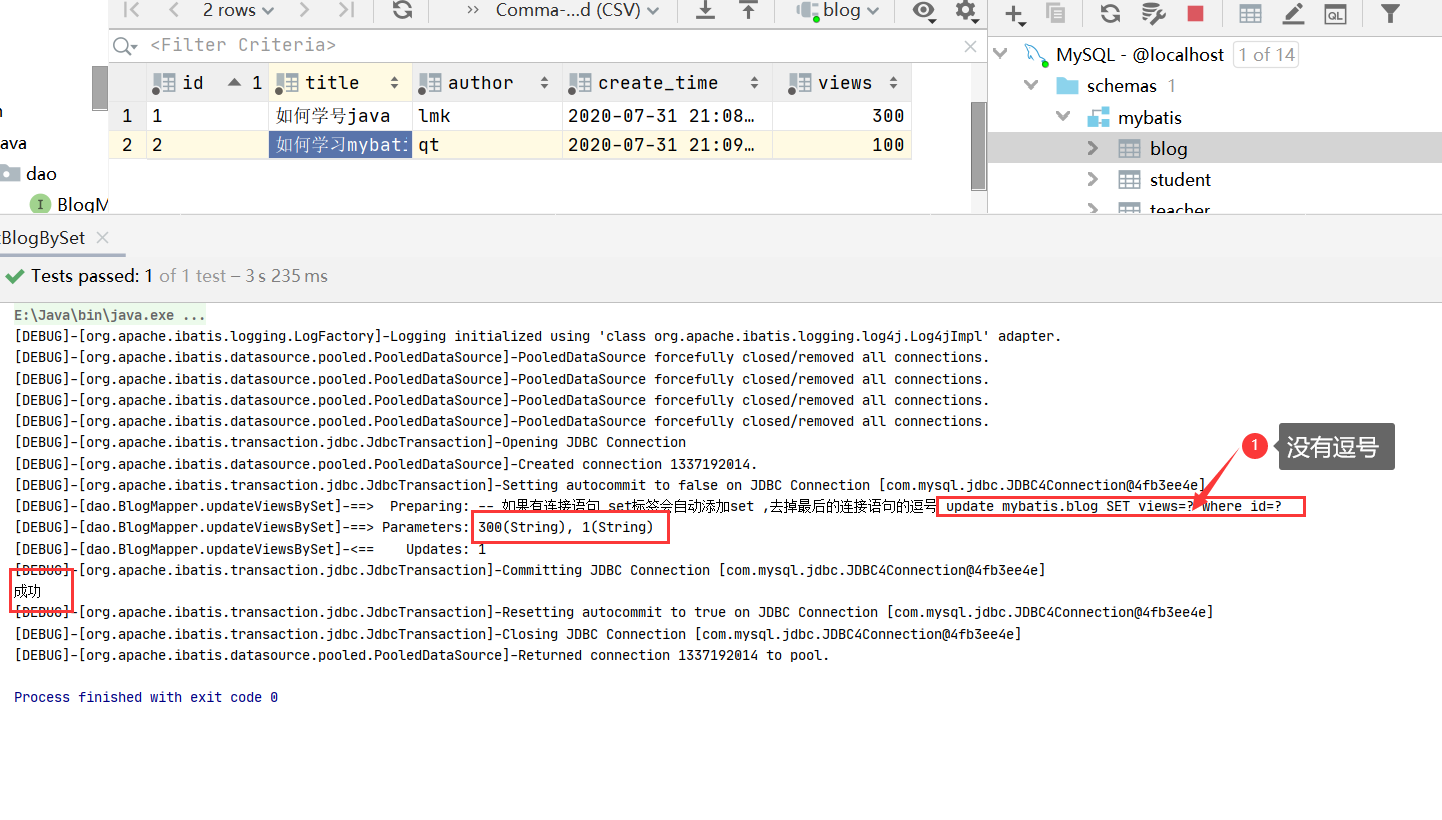动态SQL.
简单理解,根据不同的条件生成不同的SQL语句
如果你使用过 JDBC 或其它类似的框架,你应该能理解根据不同条件拼接 SQL 语句有多痛苦,例如拼接时要确保不能忘记添加必要的空格,还要注意去掉列表最后一个列名的逗号。利用动态 SQL,可以彻底摆脱这种痛苦
借助功能强大的基于 OGNL 的表达式,MyBatis 3 替换了之前的大部分元素,大大精简了元素种类,现在要学习的元素种类比原来的一半还要少。
标签元素
- 1
if - 2
choose(when,otherwise) - 3
trim(where,set) - 4
foreach
- 1
1、搭建环境.
(已配置好mybatis-config.xml配置文件,写好MybatisUtils.java工具类)
1.新建数据表
CREATE TABLE `blog`(
`id` VARCHAR(50) NOT NULL COMMENT '博客id',
`title` VARCHAR(100) NOT NULL COMMENT '博客标题',
`author` VARCHAR(30) NOT NULL COMMENT '博客作者',
`create_time` DATETIME NOT NULL COMMENT '创建时间',
`views` int(30) NOT NULL COMMENT '浏览量'
) ENGINE=INNODB DEFAULT CHARSET=UTF8;2.创建实体类
@Data
public class Blog implements Serializable {
private String id;
private String title;
private String author;
private Date createTime;
private int views;
}3.创建Mapper接口
public interface BlogMapper {
}4.创建Mapper.xml文件
<?xml version="1.0" encoding="UTF-8" ?>
<!DOCTYPE mapper
PUBLIC "-//mybatis.org//DTD Config 3.0//EN"
"http://mybatis.org/dtd/mybatis-3-mapper.dtd">
<mapper namespace="dao.BlogMapper">
</mapper>5.绑定Mapper到mybatis-config.xml
<?xml version="1.0" encoding="UTF-8" ?>
<!DOCTYPE configuration
PUBLIC "-//mybatis.org//DTD Config 3.0//EN"
"http://mybatis.org/dtd/mybatis-3-config.dtd">
<configuration>
<properties resource="db.properties">
<property name="password" value="123456"/>
</properties>
<settings>
<setting name="logImpl" value="LOG4J"/>
<!--开启驼峰和下滑线的转换-->
<setting name="mapUnderscoreToCamelCase" value="true"/>
</settings>
<environments default="development">
<environment id="oracle">
<transactionManager type="MENAGED"></transactionManager>
<dataSource type="POOLED">
<property name="driver" value="${driver}"/>
<property name="url" value="${url}"/>
<property name="username" value="${username}"/>
<property name="password" value="${password}"/>
</dataSource>
</environment>
<environment id="development">
<transactionManager type="JDBC"/>
<dataSource type="POOLED">
<property name="driver" value="com.mysql.jdbc.Driver"/>
<property name="url" value="jdbc:mysql://localhost:3306/mybatis?useSSL=false&useUnicode=true&characterEncoding=UTF-8&serverTimezone=UTC"/>
<property name="username" value="root"/>
<property name="password" value="mysql"/>
</dataSource>
</environment>
</environments>
<mappers>
<mapper resource="dao/BlogMapper.xml" />
</mappers>
</configuration>2、标签元素.
1. if.
接口方法添加.
List<Blog> getBlogByIF(Map<String, Object> map);BlogMapper.xml添加SQL语句,使用 if 标签.
测试方法.
@Test
public void getBlogByIf(){
try(SqlSession sqlSession = MybatisUtils.getSqlSession();) {
BlogMapper userDao = sqlSession.getMapper(BlogMapper.class);
Map<String, Object> map = new HashMap<>();
//map.put("title","如何学好mybatis");
map.put("author", "lmk");
List<Blog> list = userDao.getBlogByIF(map);
list.forEach(System.out::printlWn);
}
}结果展示.

2.choose (when,otherwise).
接口方法添加.
List<Blog> getBlogByChoose(Map<String, Object> map);BlogMapper.xml添加SQL语句,使用choose标签 (choose 相当于 switch ,when 相当于 case ,otherwise相当于 default).
<!-- choose 标签的使用 -->
<select id="getBlogByChoose" resultType="pojo.Blog">
-- choose 只能添加一条sql语句 默认 是 otherwise
select * from mybatis.blog where 1=1
<choose>
<when test="title != null">
and title=#{title}
</when>
<when test="author != null">
and author=#{author}
</when>
<otherwise>
and views=#{views}
</otherwise>
</choose>
</select>测试方法.
@Test
public void getBlogByChoose(){
try(SqlSession sqlSession = MybatisUtils.getSqlSession();) {
BlogMapper blogDao = sqlSession.getMapper(BlogMapper.class);
Map<String, Object> map = new HashMap<>();
map.put("views","100");
List<Blog> list = blogDao.getBlogByChoose(map);
list.forEach(System.out::println);
}
}结果显示.

3.where.
where 元素只会在子元素返回任何内容的情况下才插入 “WHERE” 子句。而且,若子句的开头为 “AND” 或 “OR”,where 元素也会将它们去除
接口方法添加.
List<Blog> getBlogByWhere(String author);BlogMapper.xml添加SQL语句,使用where标签.
<select id="getBlogByWhere" resultType="pojo.Blog">
-- 使用where 标签后 如果没有连接的sql语句,则where不做任何变化;
-- 如果有连接的sql语句,且第一个语句是以and开头,则他会自动添加where,并删掉第一个语句的and
select * from mybatis.blog
<where>
<if test="author != null">
and author=#{author}
</if>
</where>
</select>测试方法.
@Test
public void getBlogByWhere(){
try(SqlSession sqlSession = MybatisUtils.getSqlSession();) {
BlogMapper blogDao = sqlSession.getMapper(BlogMapper.class);
String author = "lmk";
List<Blog> list = blogDao.getBlogByWhere(author);
list.forEach(System.out::println);
}
}结果显示.

4.set(用于update).
set 元素会动态地在行首插入 SET 关键字,并会删掉额外的逗号
接口方法添加.
int updateViewsBySet(Map<String, Object> map);BlogMapper.xml添加SQL语句,使用set标签.
<update id="updateViewsBySet" parameterType="map">
-- 如果有连接语句 set标签会自动添加set ,去掉最后的连接语句的逗号
update mybatis.blog
<set>
<if test="title!=null">
title=#{title},
</if>
<if test="author!=null">
author=#{author},
</if>
<if test="views!=null">
views=#{views},
</if>
</set>
where id=#{id}
</update>测试方法.
@Test
public void getBlogBySet(){
try(SqlSession sqlSession = MybatisUtils.getSqlSession();) {
BlogMapper blogDao = sqlSession.getMapper(BlogMapper.class);
Map map = new HashMap<>();
map.put("views","300");
map.put("id","1");
int i = blogDao.updateViewsBySet(map);
//提交事务
sqlSession.commit();
if(i == 0){
System.out.println("失败");
}else{
System.out.println("成功");
}
}
} 结果显示.

5.trim(定制化 where 、set …).
prefix表示 需要动态添加的 关键字
prefixOverrides表示 去掉符合其值的连接语句的前缀
suffixOverrides表示 去掉符合其值的连接语句的后缀
<trim prefix="where" prefixOverrides="AND |OR ">
...
</trim>
<!--等价于-->
<where>
...
</where><trim prefix="SET" suffixOverrides=",">
...
</trim>
<!--等价于-->
<set>
...
</set>6.foreach.
用于对集合的遍历(尤其是在构建IN条件语句的时候)
接口方法添加.
List<Blog> getBlogByForeach(List<Integer> list);BlogMapper.xml添加SQL语句,使用foreach标签.
<select id="getBlogByForeach" parameterType="list" resultType="pojo.Blog">
select * from mybatis.blog
where id in
<foreach item="id" collection="list"
open="(" separator="," close=")">
#{id}
</foreach>
-- item: 本次迭代获取的对象 值(Map)
-- index: 键(Map)
-- collection 集合 (类型可以是 list,set,map ,array)
-- open:左边字符 close:右边字符 separator:分隔符
</select>
<!--
注意:parameterType 与 collection 需要对应(不管你传入的是是什么名字
以本次foreach为例,传入的类型是 List 变量名是 ids,根据对应关系,List === list,那么collection = list)
list ====== list
map ====== map的key
Object[] ====== array item:对象 item.属性名
对象 ====== 对象里面的集合字段名(List类型)
-->测试方法.
@Test
public void getBlogByForeach(){
try(SqlSession sqlSession = MybatisUtils.getSqlSession();){
BlogMapper blogDao = sqlSession.getMapper(BlogMapper.class);
List<Integer> ids = new ArrayList<>();
ids.add(1);
ids.add(2);
List<Blog> list = blogDao.getBlogByForeach(ids);
list.forEach(System.out::println);
}
}结果显示.

3、SQL片段.
有的时候,我们可能会将一些功能的部分抽取出来,方便复用!
1、使用SQL标签抽取公共的部分.
<sql id="if-title-author">
<if test="title != null">
title = #{title}
</if>
<if test="author != null">
and author = #{author}
</if>
</sql>2、在需要使用的地方使用Include标签引用即可.
<select id="queryBlogIF" parameterType="map" resultType="blog">
select * from mybatis.blog
<where>
<include refid="if-title-author"></include>
</where>
</select>注意事项:
- 最好基于单表来定义SQL片段!
- 不要存在where、set标签
所谓的动态sql,本质还是SQL语句,只是我们可以在SQL层面,去执行一个逻辑代码

